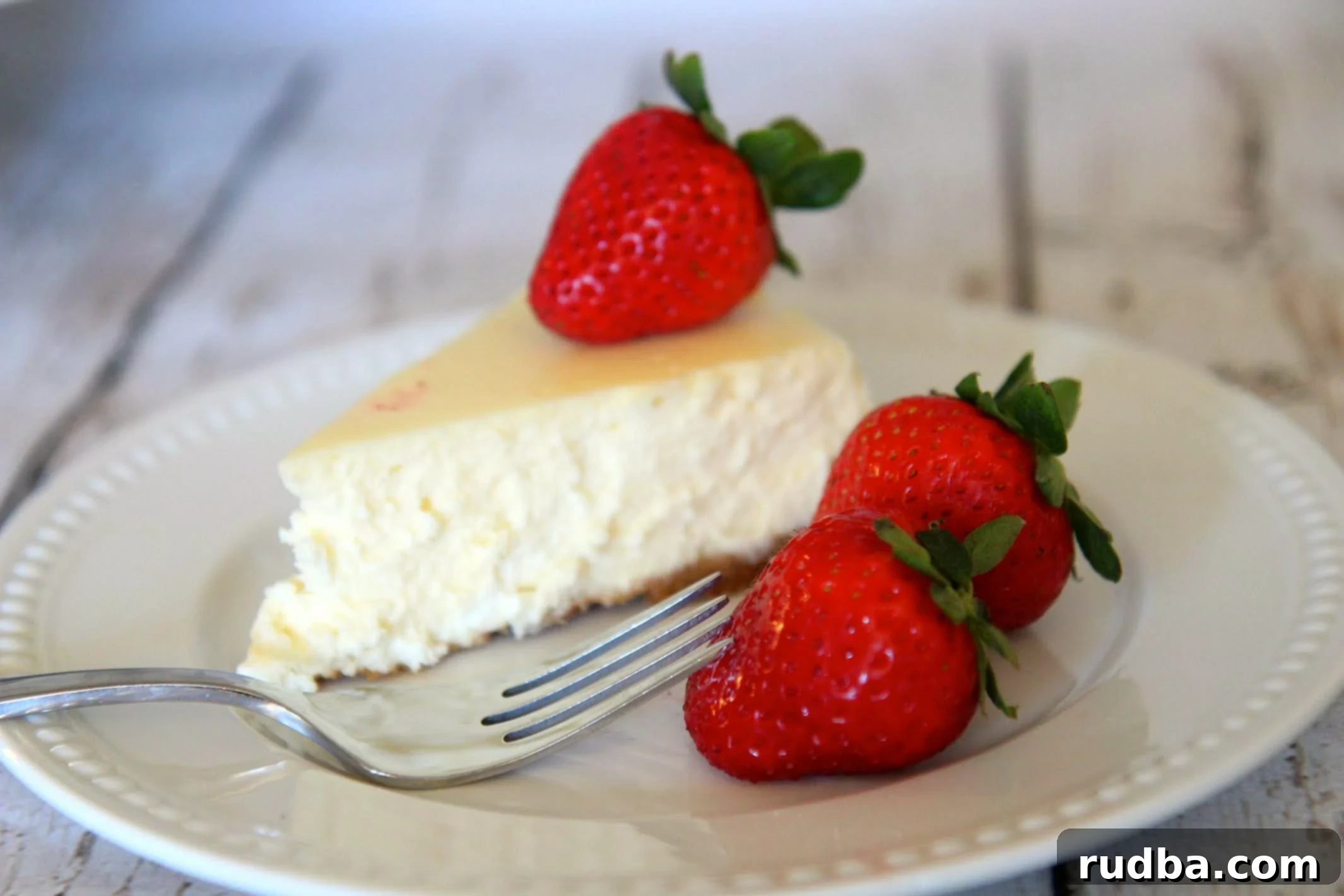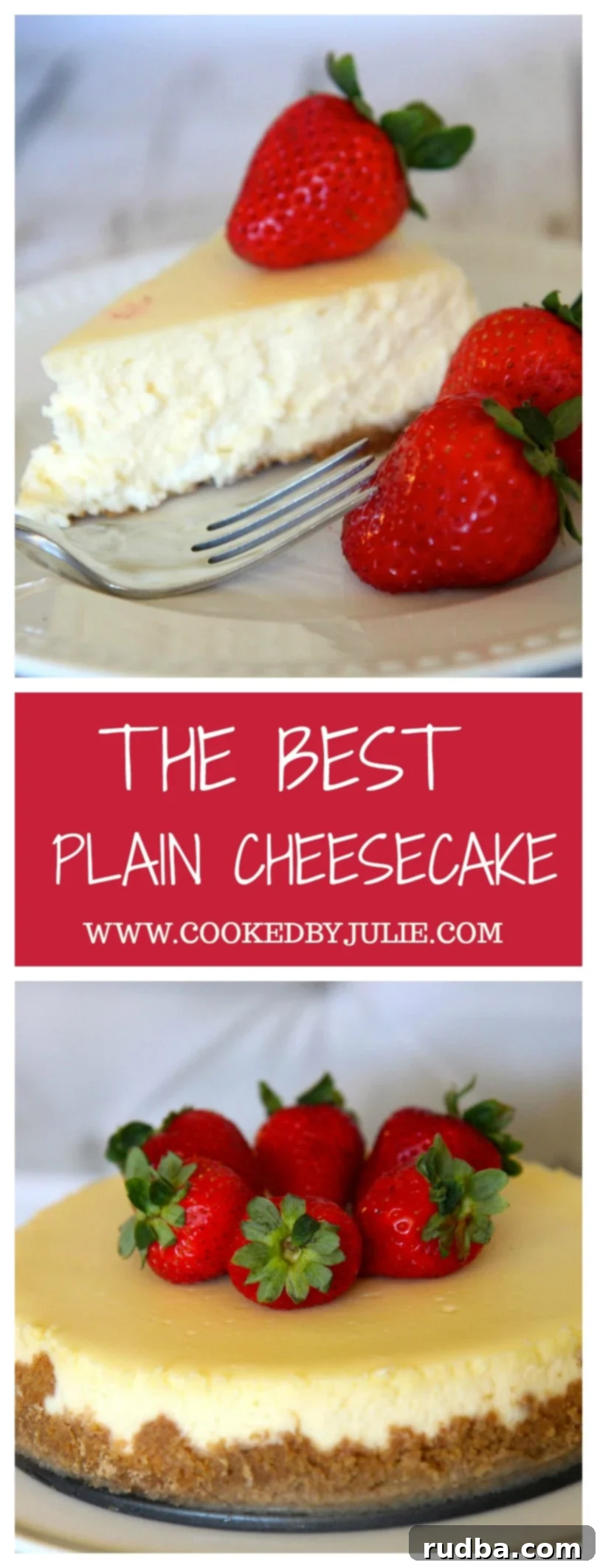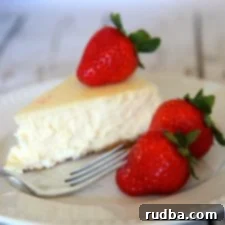Master the Art of Plain Cheesecake: Your Guide to a Creamy, Crack-Free Delight
Welcome, fellow dessert enthusiasts! Prepare to embark on a journey to create the most exquisite plain cheesecake you’ve ever tasted. This isn’t just another cheesecake recipe; it’s the foundation for every truly magnificent cheesecake I make. I stand by this base because it consistently delivers an unparalleled creamy, rich, and utterly delicious result. Forget dry, crumbly textures; this recipe promises a dessert so smooth it practically melts in your mouth.

Why This Cheesecake Stands Out: Creaminess, Richness, and No Cracks!
What truly sets this plain cheesecake apart is its exceptional texture. We’re talking about a dessert that’s incredibly creamy and lusciously rich, without being overly dense. Each bite is a harmonious blend of sweet and tangy, with a velvety mouthfeel that leaves you craving more. This recipe elevates the humble plain cheesecake to an art form, making it a showstopper for any occasion.
The Secret to Success: The Water Bath Method
Perhaps the most common frustration for home bakers attempting cheesecake is the dreaded crack. Many might think, “who cares if it cracks, I’ll just cover it with whipped cream or fruit!” And while that’s true for presentation, a crack often signifies a dry texture within the cheesecake itself. The real magic of this recipe lies in its meticulous approach to baking, specifically the use of a water bath. This technique is non-negotiable for achieving a smooth, crack-free surface and a perfectly cooked interior.
A water bath (or “bain-marie”) works wonders by creating a moist, even heat environment in your oven. The steam from the boiling water prevents the cheesecake from drying out too quickly and cooking unevenly. Cheesecake batters are delicate, and rapid temperature changes or dry heat can cause the exterior to set faster than the interior, leading to cracks as the cheesecake cools and contracts. The gentle, consistent heat provided by the water bath ensures the cheesecake bakes slowly and evenly, resulting in that dreamy, smooth consistency without any unsightly fissures. Trust me, the satisfaction of pulling a perfectly smooth cheesecake from the oven is unmatched.
Precision in Temperature: The Key to a Flawless Finish
Beyond the water bath, this recipe employs a clever two-stage baking temperature approach, followed by a gradual cooling process. Initially, we bake the cheesecake at a slightly higher temperature (325°F) for a short period to help it set slightly. Then, the temperature is reduced to a lower heat (300°F) for the majority of the baking time. This gentle, sustained heat ensures the cheesecake cooks thoroughly without overbaking or scorching.
Even more crucial is the post-baking cooling method. Instead of immediately removing the cheesecake from the oven, we allow it to cool gradually inside the turned-off oven, first with the door closed, then slightly ajar. This slow transition from hot to warm room temperature is vital. Abrupt temperature changes are a primary culprit for cheesecake cracks. By allowing it to acclimate slowly, we prevent the sudden contraction that can cause the delicate surface to split. This patience is truly rewarded with a cheesecake that is not only crack-free but also boasts an incredibly silky, uniform texture from edge to center.

Crafting the Perfect Graham Cracker Crust
Alright, before I continue to sing the praises of this cheesecake, I’m pretty sure you’ve noticed the slightly crooked crust in one of my photos! Haha, I honestly don’t know what happened there. It just goes to show that even seasoned bakers have their off days. While that particular crust might not be Pinterest-perfect, the good news is that achieving a perfectly even graham cracker crust is actually quite simple and entirely within your reach with a few straightforward tips.
For a truly exceptional crust, start with good quality graham cracker crumbs. You can buy them pre-crushed or crush your own in a food processor for a finer texture. The key to a solid, even crust is the melted butter and thorough pressing. Ensure your butter is fully melted and mixed completely with the crumbs until it resembles wet sand. When pressing the mixture into your springform pan, use the bottom of a flat-bottomed glass or a measuring cup to create an even, compact layer across the bottom and slightly up the sides. This ensures a firm crust that won’t crumble when you slice into your cheesecake.

Essential Ingredients for Cheesecake Success
The beauty of a plain cheesecake lies in the quality of its core ingredients. There are no elaborate flavors to hide behind, so make sure you’re using the best possible components. Here’s what you need to know:
- Cream Cheese: Opt for full-fat, block cream cheese. Avoid whipped or low-fat varieties, as they contain more water and stabilizers that can compromise the texture and richness of your cheesecake. It’s crucial for the cream cheese to be fully softened to room temperature. This allows it to blend smoothly without lumps, reducing the need for excessive mixing, which can incorporate too much air and lead to cracks.
- Sugar: Granulated sugar provides sweetness and helps with the structure. Don’t be tempted to reduce it too much, as it also contributes to the cheesecake’s creamy texture.
- Sour Cream: This ingredient is a game-changer! Sour cream adds a delightful tang that balances the sweetness of the cheesecake and contributes significantly to its luxurious creaminess. Like the cream cheese, ensure it’s at room temperature for seamless incorporation.
- Eggs: Eggs are the binder that sets the cheesecake. Again, room temperature is key. Add them one at a time and mix just until incorporated. Overmixing eggs can introduce too much air, leading to a “soufflé-like” rise during baking and subsequent cracking upon cooling.
- Vanilla Extract: A good quality vanilla extract enhances all the other flavors, giving your plain cheesecake that classic, comforting aroma and taste.
Step-by-Step Perfection: Mastering the Method
While the detailed recipe card below provides precise instructions, understanding the ‘why’ behind each step will elevate your cheesecake baking from good to truly exceptional. Here are some additional insights:
- Preheating is Paramount: Don’t rush this step. A consistently preheated oven is crucial for the initial setting of the cheesecake.
- Springform Pan Preparation: Wrapping your springform pan securely with aluminum foil is essential for the water bath. Ensure no water can seep in, protecting your crust from becoming soggy.
- Crust Creation: As mentioned, pressing the graham cracker mixture firmly and evenly is key. A uniform crust ensures a stable base and consistent bake.
- Cream Cheese Beating: Beat the softened cream cheese until it’s perfectly smooth and lump-free. This forms the velvety base of your filling.
- Gentle Mixing: When adding sugar, sour cream, and vanilla, mix until just combined. The goal is to create a homogenous mixture without incorporating excess air.
- Adding Eggs Carefully: This is a critical step. Add eggs one at a time, mixing on low speed only until the yolk disappears. Overmixing at this stage is the leading cause of cracks!
- The Water Bath Setup: Place your foiled springform pan into a larger baking dish before pouring in hot water. About an inch of boiling water is usually sufficient. This creates that essential steamy environment.
- Baking and Cooling Protocol: Strictly follow the temperature changes and gradual cooling instructions. Resist the urge to open the oven door during baking or cooling, as this can cause sudden temperature shifts leading to cracks.
- The Knife Trick: Running a thin knife around the edge of the cheesecake *after* it has cooled slightly prevents it from sticking to the pan as it continues to cool and contract, which can also cause cracks.
- Patience in Chilling: The minimum 4-hour refrigeration time is not just a suggestion; it’s vital. Chilling allows the cheesecake to fully set, develop its final texture, and become firm enough for clean slices.
Serving Suggestions for Your Masterpiece
A plain cheesecake is a canvas, and while it’s absolutely divine on its own, it also pairs beautifully with a variety of toppings:
- Fresh Berries: A classic for a reason! Strawberries, raspberries, blueberries, or a mix of all three add freshness, color, and a touch of tartness that complements the rich cheesecake perfectly.
- Fruit Compote: A homemade berry or cherry compote can add a lovely cooked fruit flavor and a beautiful syrupy glaze.
- Chocolate Drizzle: Melted dark or milk chocolate drizzled over the top is a simple yet elegant addition for chocolate lovers.
- Caramel Sauce: A luscious salted caramel sauce adds a layer of sweet, buttery sophistication.
- Whipped Cream: A dollop of freshly whipped cream lightens the richness and adds a cloud-like texture.
- Lemon Curd: For those who enjoy a brighter, more zesty flavor, a spoonful of lemon curd can be a fantastic topping.
Storage Tips for Leftover Cheesecake
If you’re lucky enough to have leftovers (it’s rare!), proper storage will keep your cheesecake fresh and delicious:
- Refrigeration: Store leftover cheesecake covered tightly with plastic wrap in the refrigerator for up to 3-4 days. This prevents it from absorbing odors from other foods and keeps it moist.
- Freezing: Cheesecake freezes beautifully! For best results, chill the cheesecake thoroughly. You can freeze individual slices or the whole cheesecake. Wrap it tightly in plastic wrap, then again in aluminum foil. It can be frozen for up to 1 month. Thaw in the refrigerator overnight before serving.
Common Cheesecake Mistakes and How to Avoid Them
Even with a perfect recipe, a few common pitfalls can trip up a baker. Here’s how to steer clear of them:
- Overmixing the Batter: As emphasized, this is the number one cause of cracks. Too much air whipped into the batter causes it to puff up in the oven and then collapse, leading to cracks. Mix on low speed, and only until just combined.
- Skipping Room Temperature Ingredients: Cold cream cheese or eggs won’t blend smoothly, leading to a lumpy batter or requiring excessive mixing to smooth out. Plan ahead!
- Not Using a Water Bath: While some recipes claim to be “no-water-bath,” for a truly creamy, crack-free cheesecake, the water bath is your best friend.
- Opening the Oven Door: Resist the urge to peek! Sudden changes in temperature and humidity can cause the cheesecake to crack. Use your oven light to check.
- Improper Cooling: Pulling the cheesecake out of the oven too soon or cooling it too quickly can also result in cracks. Follow the gradual cooling process diligently.
Frequently Asked Questions (FAQ)
Here are some common questions you might have about making this plain cheesecake:
- Q: Can I use different types of crackers for the crust?
A: Absolutely! While graham crackers are classic, you can experiment with digestive biscuits, shortbread, or even Oreo cookies for a chocolate crust. Just ensure the crumb-to-butter ratio feels similar. - Q: My cheesecake still cracked! What went wrong?
A: Don’t despair! Most likely, it was due to overmixing, opening the oven door too often, or not allowing it to cool slowly enough. Even if it cracks, it will still taste delicious, and you can always cover it with toppings. Practice makes perfect! - Q: How do I know when the cheesecake is done baking?
A: The edges should be set, but the center (about a 2-inch circle) should still have a slight jiggle when you gently shake the pan. It will continue to set as it cools. - Q: Can I make this cheesecake ahead of time?
A: Yes, in fact, cheesecake is often better made a day in advance! This allows the flavors to meld and the cheesecake to fully set and firm up, making for easier slicing and a better texture. - Q: Can I substitute Greek yogurt for sour cream?
A: While Greek yogurt can add tang, it’s typically thicker and might alter the final texture slightly. For the best creamy results, stick with sour cream as specified in the recipe.
Now, let’s get to the recipe that will change your cheesecake game forever. Happy baking!

Plain Cheesecake
Save RecipeSaved Recipe
Pin Recipe
Rate Recipe
Print Recipe
Ingredients
Crust
- 1 1/2 cups graham crackers
- 7 tbsp unsalted butter
Filling
- 24 ounces softened cream cheese
- 1 cup sugar
- 1 cup sour cream
- 3 eggs
- 1 tsp vanilla extract
Instructions
-
Preheat oven to 325 F.
-
Wrap an 8-inch springform pan with aluminum foil, Set aside.
-
Add melted butter to the graham cookie crumbs and press onto the bottom of an 8-in. spring form pan, Set aside.
-
For filling, beat the softened cream cheese until smooth.
-
Add sugar, sour cream, and vanilla and mix until well incorporated.
-
Add the eggs one at a time and mix until incorporated, do not overmix.
-
Pour the filling over the crust.
-
To prepare the water bath, place the 8-inch springform pan into a larger baking dish and pour in some boiling water, about 1 inch of water.
-
Place the cheesecake in the prepared water bath in the oven and let it bake for 10 minutes.
-
Reduce the heat to 300 F and let it bake for an additional 1 hour and 15 minutes.
-
Turn the oven off and let it sit in the oven for 30 minutes.
-
Open the oven doors slightly and let it sit for an additional 10 minutes.
-
Carefully remove cheesecake from water bath and run a knife along the sides.
-
Let the cheesecake cool at room temperature for about 1 hour and then place it in the fridge for a minimum of 4 hours.
-
Decorate it with fresh strawberries, if desired and enjoy!
Video
Nutrition
Nutrition information is automatically calculated, so should only be used as an approximation.
Additional Info
Like this recipe? Leave a comment below!
